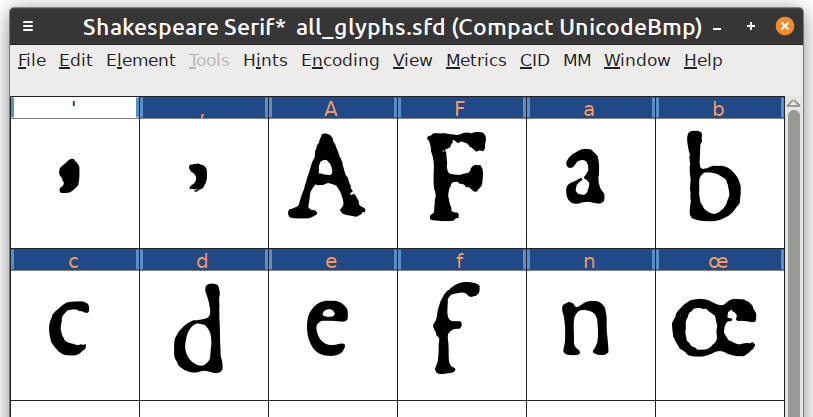I’ve built a new font! Thoughts and feedback on my approach very welcome.
Very cool! That did not look easy to do.
Thanks :-) It was a couple of days work. Mostly teaching myself stuff that I’d forgotten. I blogged about it so others can follow the process if they want.
Fantastic project! And thanks for the heads up about the 17th century Dutch fonts - I might consider that for the printed version of my thesis that will probably rot away in the university library anyway. Might as well make it interesting looking.
My favourite project of this kind is TT2020, which takes typewriter imitation to the next level by including irregularities within the font itself. Each (common) glyph has several versions, making the outcome look much more genuine and allowing for the occasional badly printed glyph without making the same error repeat itself to infinity.
It’s a bit overkill maybe, but it would absolutely lend itself well to Shakespearian scripts. :)
Oh! That is very clever. Thank you.
This is so cool! Not just the font but the whole process and study. Please feel free to cross-post to Typography & fonts.
Done! Thanks :-)
This is very cool. I’m looking forward to seeing the progress!
Do modern day fonts even support automatic ligatures? How does that work? Or are there Unicode symbols for them?
Both! Unicode has some support for as-is ligatures. For example
fiis U+FB01.Modern fonts can also use self-defined ligatures. That’s how fonts like https://www.sansbullshitsans.com/
So my plan is (eventually) to add in ligatures where Unicode has defined them - and automatically replace typed text with self-defined ligatures where it doesn’t.
Yes, they do. Part of the OpenType standard are the so called “OpenType features” which (amongst other things) allow for contextual alternates, i.e. different kinds of ligatures, and for stylistic alternates, e.g. a slashed zero, a single-storey ɑ, etc. All of these different glyphs are encoded in the font and can be enabled when typesetting using different selectors. This website shows them off.
Some ligatures, like “ffl”, are a separate character in Unicode. Some were added because they can be considered a different character in languages other than English. Some (like “ffl”) were added because of legacy reasons; “no more will be encoded in any circumstances”.
Of course they do, better than ever actually. Google OpenType ligatures, for example. You can even use those on the web using CSS.
Some fonts have hundreds of different ligatures.
Oh, I love everything about this project so much! It looks lovely!
It also looks mighty useful for making handouts for TTRPG campaigns ahaha.
Was the letter-recognition Python codeblock of your own making?
Cheers. The code was cobbled together by me from various random tutorials and things I had laying around.
Oooh, I’m excited to try this out! But later, 'cause I’m just on mobile, and kbin doesn’t have a save function yet lol.
Looks nice
Cheers! I’m hoping to add some more letters and tidy up the rest when I have more time.
This is such a great project! I can see how there’s a little room for clean-up on that long S. Plus the comma-looking apostrophe 😵💫. Although maybe that’s how that punctuation mark acted back then?
Nah, that’s just me not adjusting the positioning of the apostrophe. Lots of clean-up to do :-)
You’ve really retained the slightly blotted look of the print. Great work!
Thanks! I’m chuffed with how they turned out.













